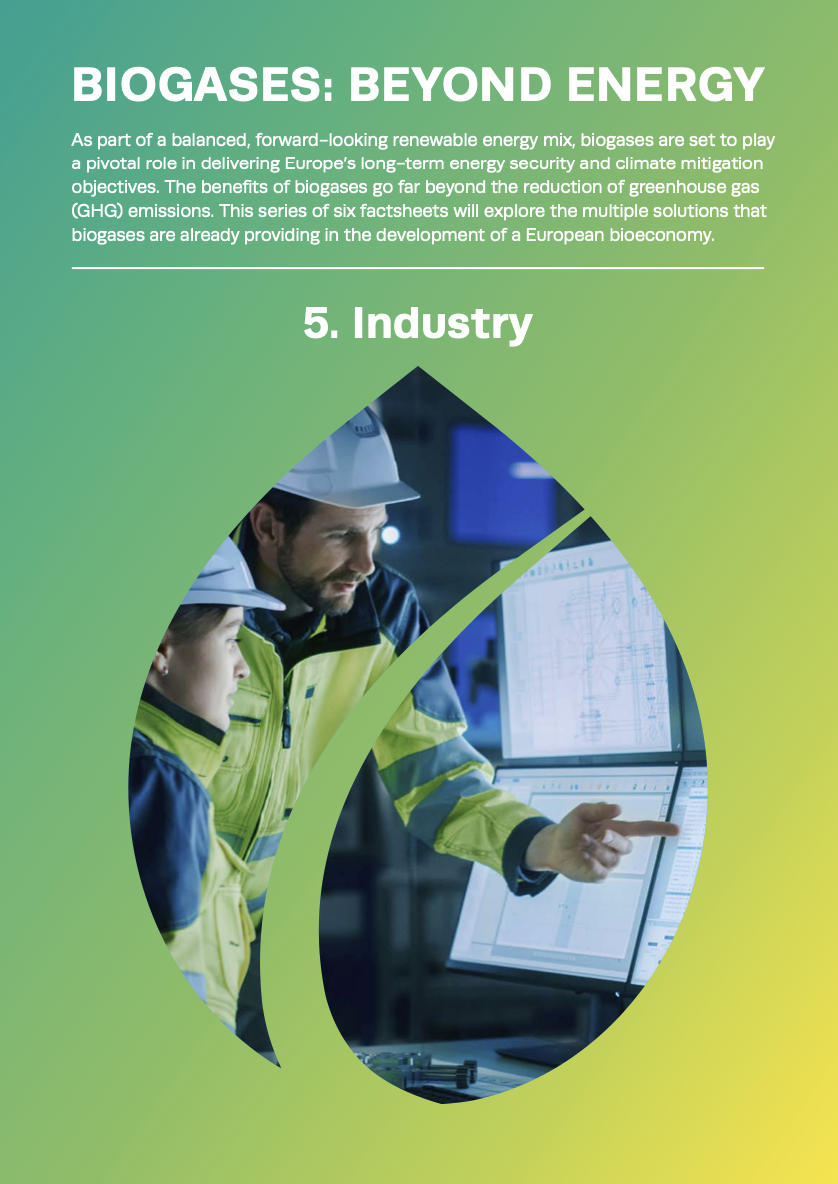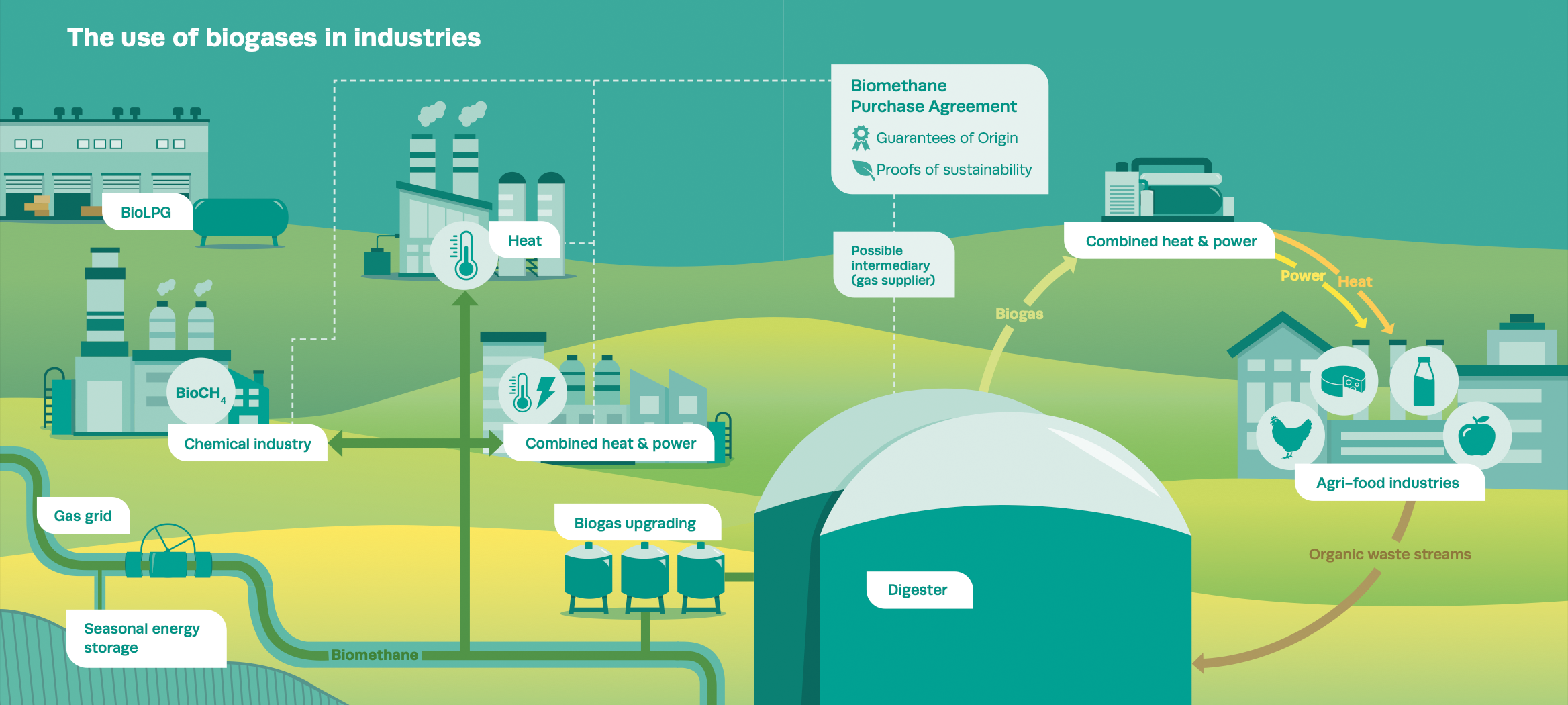Biogases will play a pivotal role in delivering Europe’s long-term energy security and climate mitigation objectives, as part of a forward-looking and balanced renewable energy mix. Besides, their benefits go far beyond the reduction of greenhouse gas (GHG) emissions. That is why attention to this source of renewable energy and scientific developments regarding biogas is increasing.

A series of six fact sheets explores the various solutions that different types of biogas already offer for the development of the European bioeconomy.
We are glad to announce that the fifth factsheet “Industry” of the European Biogas Association (EBA) information campaign “Biogases: beyond energy” has already been published. The document is focused on the role that biomethane plays in meeting industrial needs.
You can get acquainted with the four previous ones and the list of future publications by following the link.
Industry’s energy needs
Industry was responsible for more than a quarter of the EU’s final energy consumption in 2021. However, less than 10% of the industrial energy demand that year was met using renewable sources. Natural gas, in contrast, accounts for 33% of the energy use in the industrial sector.
The transition to low-carbon industry in Europe will require an array of tools because of the diversity of the processes involved. Energy needs vary tremendously. Gas can be used to generate process heat or to provide methane for use as a feedstock. Biogases can meet the needs of a wide range of processes, especially those requiring high temperatures and steam pressure. In 2022, 18% of upgraded biogas was used in industry, and this figure is set to increase.
How can biogases help to decarbonise industrial processes?
- Biomethane can directly replace natural gas for both energy and feedstock purposes, because biomethane is just like natural gas: it is chemically equivalent and contains the same amount of energy.
- BioLPG can replace fossil LPG using the same delivery method (trucks refilling on-site tanks).
- Raw biogas or biomethane can produce renewable electricity, heat and steam on-site via combined heat and power generators (CHP).
- Biomethane can be easily sourced using the existing gas networks. It is fully compatible with existing gas infrastructure and end-use appliances (boilers, furnaces, etc.), meaning that there is no adaptation cost for industries already using natural gas.

Facts
Which industrial sectors could utilise biogases to decarbonise their production?
Biomethane can be used in all sectors that use natural gas:
- As an energy source in the chemical, glassmaking or other non-metallic mineral industries; in the pulp and paper industry; in steelmaking, or in the food and beverage industry.
- As a feedstock – in fertiliser, methanol, or steel manufacturing.Biomethane is particularly suited to high temperature processes in energy- intensive industries thanks to its high energy density, which is equivalent to natural gas. Raw biogas is particularly suited to agri-food industries producing organic residues.
Can industrial companies use their own organic residues to green their products?
Agri-food factories can turn their organic waste into biogas that can generate electricity, heat, or steam on-site, depending on the company’s requirements. They thus reduce their Scope 1 and Scope 2 emissions[1].
For example, manufacturers of frozen vegetables can use biogas to power the freezing process. Wastewater and solid residues from the processing of potatoes or sugar or the production of paper or beer can be used to generate biogas that provides electricity, heat or steam for the production process.
In addition, the digestate can be used as organic fertiliser in the partner-farms of agri-food companies, thus reducing their Scope 3 emissions*.
What financial drivers can encourage the uptake of biomethane in industry?
Biogases offer cost-effective decarbonisation in several ways:
- On-site production of biogas creates additional revenues and saves energy and waste treatment costs.
- Sourcing sustainable biogases allows carbon cost savings under the EU Emissions Trading Scheme (ETS).
- The purchase of biomethane using Biomethane Purchase Agreements replaces natural gas in a cost-effective way, in contrast to other low- carbon energy carriers.
Energy-intensive industries can benefit from the preferential treatment of biogases under the EU ETS. Biogases are zero-rated in emissions accounting, as long as a purchase record and a compliant proof of sustainability can be provided. Companies can thus avoid the purchase of emission allowances and reduce their production costs. The increases to the ETS carbon price as a result of evolving EU legislation will make this option increasingly attractive.
What is a BPA and how can this help?
A Biomethane Purchase Agreement (BPA) is a contract between a biomethane producer and an industrial consumer, in which the price and the duration is negotiated by the parties involved. The origin of the biomethane purchased can be precisely identified thanks to the Guarantee of Origin that is provided to the industrial consumer. Biomethane can be sourced from one or several production facilities.
A BPA provides long-term price stability for both parties, as well as independence from a public support scheme for the producer. It is a viable growth pathway for the biomethane sector outside of operational subsidies, alleviating the burden on state finances.
[1] Scope 1: direct emissions from a company’s activities, including fuel combustion; Scope 2: indirect emissions from the generation of the purchased energy; Scope 3: indirect emissions from further up and down the value chains.
Read more about the information campaign at the link.
Download the first factsheet “Energy system integration” here.
Download the second factsheet “About regenerative agriculture” here.
Download the third factsheet “Transport” here.
Download the fourth factsheet “Heating” here.
Download the fifth factsheet “Industry” here.